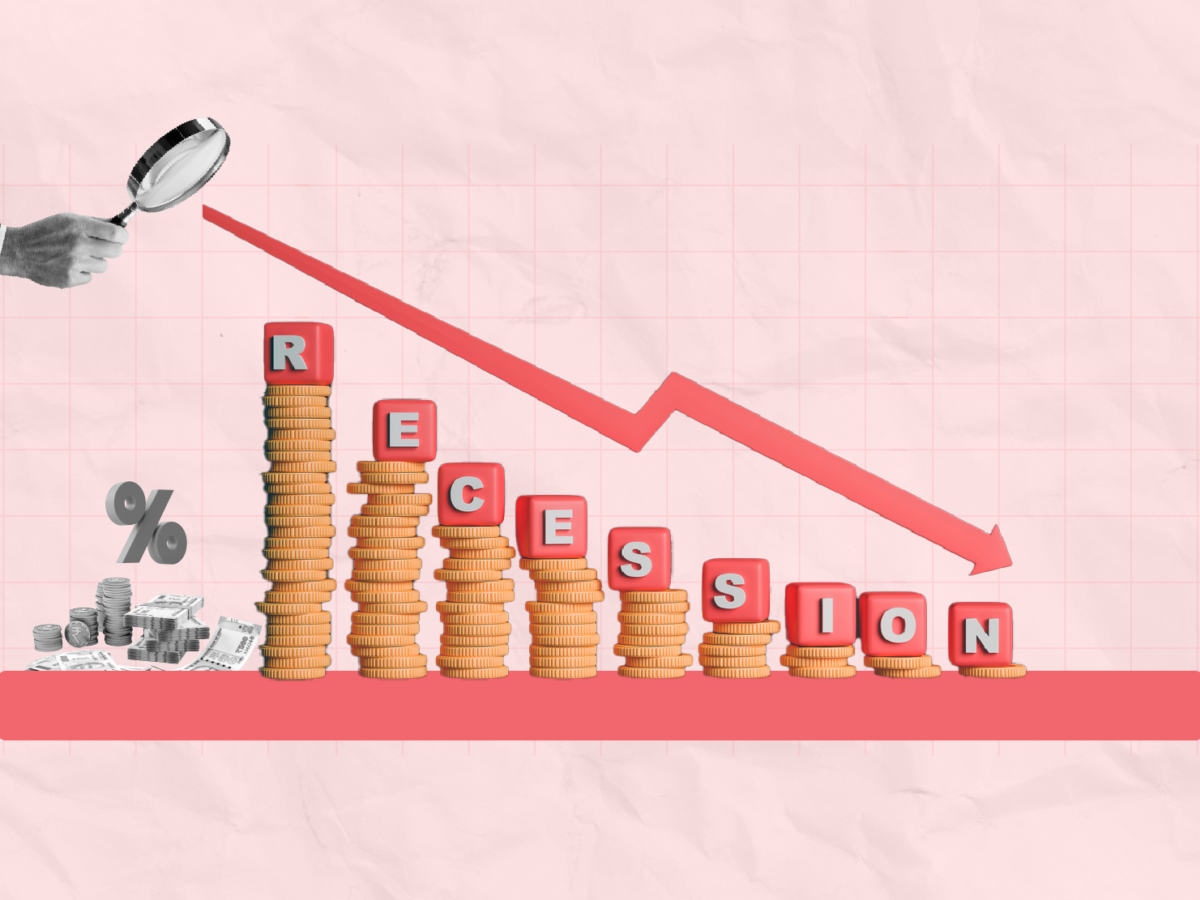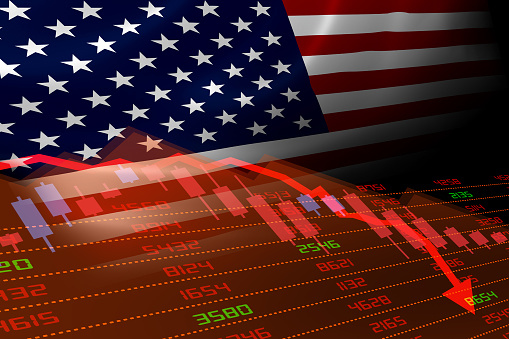USA To Enter Recession In The Third Quarter Of 2023 And First Quarter Of 2024?
Leading Indicators Of USA Point to Recession Starting from 3rd Quarter of 2023 until 1st Quarter of 2024

USA To Enter Recession In The Third Quarter Of 2023 And First Quarter Of 2024?
June’s Leading Economic Index Decline Signals Looming Economic Downturn
An ominous sign raises the possibility that a recession is approaching as the economy of the United States struggles to keep up with growing demands. In June, the Leading Economic Index (LEI), a crucial indicator used to follow changes in American economic cycles, posted its 15th consecutive monthly fall. Concerns with regard to the probable start of a recession were raised as a result of the fall, which was caused by a deteriorating consumer outlook as well as an increase in unemployment claims. The LEI has been declining for the greatest period of time since the run-up to the 2007–2009 financial crisis, which gives the fears even more credibility.
In accordance to The Conference Board’s analysts, economic growth will slow down even further in the upcoming months, with a recession likely to hit the United States starting from the third quarter of this year as long as the first quarter of 2024.
The Leading Economic Index Plummets
Following a revised decline of 0.6% in May, the Leading Economic Index dropped by 0.7% in June to a level of 106.1, according to the Conference Board. This loss exceeded expectations just a little bit because, according to a Reuters poll of economists, a 0.6% decline was forecast. The Conference Board’s Justyna Zabinska-La Monica, Senior Manager of Business Cycle Indicators, stressed that the data from June indicate that the pace of the economy will continue to slow down in the months to come. Numerous variables affecting the country’s economic climate have made this troubling tendency worse.

Factors Influencing the Downturn
- Increased prices: The problem of high pricing is one of the main causes supporting the forecast of a likely recession in the USA by the conclusion of 2023. Increasing prices for products and services can result in consumers having less purchasing power leading to them spending less, and this thereby has an impact on the overall growth of the economy. Consumers may reduce discretionary spending when prices rise, which would slow down demand as well as overall economic activity.
- Stricter monetary regulations: Another important element affecting the economy is the Federal Reserve’s decision to tighten monetary policies. The central bank raised interest rates and implemented measures to tighten the money supply as a response to the inflation crisis. Although these measures aim to reduce inflation, they may also discourage individuals and businesses from borrowing and investing, which would limit economic growth.
- Government spending has decreased: The government’s choice to reduce spending as part of its fiscal policy may have an effect on economic expansion. Reduced government spending may result in less money being invested in crucial industries like education as well as infrastructure. The economy may be further strained as a result of lower economic activity and likely job losses.
- Restricted credit access: Credit availability is essential for both individuals and businesses in order to invest, grow, as well as make big purchases. If credit access is restricted, investments and corporate expansion plans may be hampered. Additionally, it may have an impact on consumer purchasing, particularly for expensive products like houses and automobiles, which might cause a slowdown in a number of economic sectors.
- Disruptions in the supply chain: The persistent supply chain disruptions have presented the American economy with significant difficulties. These setbacks may result in a shortage of essential products and parts, delaying production and raising expenses for firms. Economic growth may be further slowed down if supply chain bottlenecks prevent companies from meeting consumer demand.
- Lack of labor: In many industries, there has been a labor shortage, which can hurt output and production. Businesses that are having trouble filling open positions may not be able to effectively meet customer needs, which could result in decreased economic activity as well as potential job losses.
- Soaring inflation: Consumers’ purchasing power is diminished and their faith in the economy is decreased by the inflation’s ongoing increase. When consumers put off purchases and investments because they anticipate price increases, economic activity suffers. High inflation can also have a detrimental effect on savings and fixed-income earners, increasing economic instability.
- Decreased customer confidence: Consumer confidence has declined as a result of the above-mentioned combination of variables, including price increases, supply chain disruptions, as well as labor shortages. Consumers are more likely to be cautious with their spending when they lack faith in the economy’s future, which lowers the demand for products and services.
In a nutshell, a number of variables that have together slowed economic development are the foundation for the projection that the United States may have a recession by the end of 2023. The difficulties facing the economy are caused by high pricing, stricter monetary regulations, less government investment, constrained credit access, interruptions in the supply chain, labor shortages, skyrocketing inflation, and decreased consumer confidence. Together, these elements may result in a decline in consumer spending, investment, and economic activity, which may eventually trigger a recessionary period.
HSBC Asset Management Predicts U.S. Downturn and European Recession in Midyear Outlook
Recession warnings are “Flashing Red” as markets are misaligned with fiscal and monetary policies- The asset management division of the large British bank, HSBC Asset Management, has offered a sobering forecast for the world economy in its midyear outlook. According to the business, a downturn in the US economy would start in the fourth quarter, which would be followed by a “year of contraction” as well as a European recession in 2024. Asset management notes that fiscal and monetary policies are out of step with stock and bond markets, while recession warnings are at the moment “flashing red” for a number of economies.
The global head strategist at HSBC Asset Management, Joseph Little, noted that the economy has so far showed some resilience in some sectors. He emphasizes that despite Europe lagging behind the United States in the economic slowdown and its broader macro trajectory matching with the possibility of a global recession, the balance of risks currently shows a high recession risk. In a media report, Little cautioned, “We are already in a mild profit recession, and corporate defaults have started to creep up too.”

Expectations of Inflation Moderation and Interest Rate Cuts
HSBC Asset Management anticipates that the U.S. Federal Reserve will lower interest rates before the end of 2023, notwithstanding the hawkish stance taken by central bankers and the continuance of inflation, particularly at the core level. Next year, it’s expected that both the Bank of England and the European Central Bank will decrease interest rates.
The Fed had stopped its cycle of monetary tightening at its meeting in June, leaving the target range for the federal funds rate at 5% to 5.25%. The central bank did, however, say that two other rate increases could be anticipated later this year. According to the FedWatch tool from CME Group, market pricing presently expects the fed funds rate to be one-quarter of a percentage point higher in December.
Little underlined that if inflation is much above target, as it is in many large nations, central banks may not be able to reduce rates appreciably. It is crucial that the recession not start too soon and result in disinflation.
Recession Scenario and Outlook for Markets
According to HSBC Asset Management, the impending recession in Western nations would bring about a “difficult, choppy outlook for markets” because of the quickening tightening of financial conditions that will cause the credit cycle to shift downward. Investors may face difficulties because markets do not now reflect a very negative perspective of the world.
Little made the argument that the system’s inflationary pressures might not be completely relieved by this recession. As a result, industrialized economies may eventually experience a regime of slightly higher inflation as well as interest rates. Because of this, the asset management company adopts a circumspect approach to risk as well as cyclicality in portfolios. Interest rate exposure, especially in the front and middle of the Treasury curve, is desirable, and HSBC Asset Management additionally believes that European bonds are valuable.
The emphasis in the credit markets is on investment-grade, higher quality credits rather than on- speculative investment-grade credits, as well as developed market stocks which ought to be approached cautiously.
Backing China and India
As China emerges from the strict Covid-19 lockdown restrictions, HSBC Asset Management continues to have a positive outlook on its prospects. According to the firm, high levels of household savings will sustain domestic demand, issues in the real estate industry are at their lowest point, and government budgetary initiatives should lead to job creation. These elements, together with the relatively low inflation rate, allow for more monetary policy easing, which is anticipated to result in GDP growth that exceeds the government’s modest 5% target this year.
India is cited by HSBC Asset Management as the primary macro-growth story for 2023, along with China. Due to rebounding consumer expenditure and a strong services sector, the Indian economy has recovered strongly from the pandemic. India’s growth prospects are further improved by improved business along with bank balance sheets, which are supported by government subsidies, supporting the country’s long-term investment thesis. Investors as well as policymakers will closely monitor the latest developments as they manoeuvre through this era of economic turmoil as the global economy faces growing uncertainty and obstacles.
Recession Forecast
The Conference Board’s prediction for the American economy is bleak. An accelerated downturn is indicated by the Leading Economic Index’s continued decreases, which have increased to 4.2% over the past six months from 3.8% from June to December 2022. Furthermore, the most current predictions of the likelihood of a recession, which hover above 99 percent, indicate that one is likely to occur within the following twelve months.
In the period spanning from September 2020 to March 2022, following the start of the global pandemic, the likelihood of a recession remained low. The odds, however, sharply shifted, rising above 30% in April, and nearing 50% in May. Since that time, the probability of a recession continues to be high, suggesting that the US economy will probably experience one during the next 12 months.
)
Impact on GDP and Consumer Spending
Despite unexpectedly strong GDP growth in late 2022 as well as early 2023, experts still project a three-quarter GDP decline beginning in Q2 2023. Although consumer spending has turned out to be better than anticipated, the Federal Reserve’s anti-inflation actions, such as interest rate increases as well as tightening of monetary policy, are projected to exacerbate the economic slowdown and eventually lead to a period of recession in 2023.
Way Forward
The persistent decrease in the Leading Economic Index is a glaring indicator of a probable recession on the horizon as the U.S. economy grapples with growing obstacles. In the upcoming months, economic activity in the country is predicted to slow down even more, having an effect on a number of industries and consumer confidence. Policymakers, companies, and individuals must prepare for the risk of an economic downturn in mid-2023 as the likelihood of a recession is increasing and the LEI is continuing to decline. Strategic actions and intervention may be required as events develop in order to lessen the effects and open up the possibility for a strong recovery.




